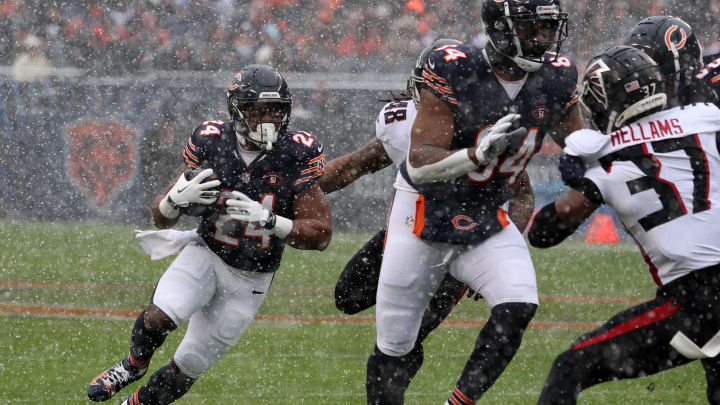Do Bears Running Backs Really Rate in the NFL's Bottom Half?

One of the great fears about this year's Bears offense is again a topic of conversation.
Earlier this year the Bears running back group took a huge hit in an analysis piece by CBS Sports' Tyler Sullivan. He graded Bears backs in the middle of the pack after two years when the team was first and second in rushing.
Now Pro Football Focus' Trevor Sikkema has come up with the same type of evaluation of their backs
If accurate, it all seems like enough to make their missed opportunity to sign Saquon Barkley one they could regret.
Sikkema has the Bears graded 19th as a running back group, or near the top of the league's bottom half. He has them as the worst running back group in the NFC North, after they had the best rushing attack in the NFC North.
#Bears
— Matt Bowen (@MattBowen41) September 12, 2023
Rookie RB Roschon Johnson.
Play downhill. pic.twitter.com/auWbx7bWj3
Even Tennessee, post-Derrick Henry, and the Rams, who yawn when they think of the run, have running back groups rated better by PFF than the Bears.
Why Analysis of Bears Backs Is Off
Too little analysis of Bears running backs focuses on the potential for Roschon Johnson and too much on what Khalil Herbert and D'Andre Swift have accomplished or failed to do.
WHY CONNOR WILLIAMS MIGHT NOT BE A BAD IDEA FOR BEARS
BEARS TRAINING CAMP REPORTING DATE SET FOR JULY 19
CALEB WILLIAMS' EURO VACATION EXCITES SOCIAL MEDIA
THE OTHER WAY CALEB WILLIAMS IS SET UP BETTER THAN JUSTIN FIELDS
Caleb Williams to Khalil Herbert 🐻⬇️ pic.twitter.com/u7GlxQPnJa
— Caleb Williams Fan Club (@CalebFC18) June 6, 2024
Johnson is the real X-factor on this year's Bears offense as someone who is underrated for his blocking and receiving ability but who supplies untapped and valued power running.
Yet, Sikkema calls Herbert the "dark horse" of the group because he averaged .24 and .25 missed tackles forced per attempt the past two years while averaging over 4.5 yards a carry.
Herbert's ability is well known. He was the starter. He averaged 5.7 yards a carry and led all NFL running backs with 100 carries or more in yards per attempt in 2022. It's just his team that values him too little.
Swift is being undersold universally largely because of the way he finished last season in Philadelphia.
I think we can stop worrying about losing Khalil Herbert to free agency in 2025.#DaBears pic.twitter.com/MXNBRu7VvV
— Rob Schwarz Jr. (@ChiRuxinBGO) June 11, 2024
"Swift racked up the most rushing yards of his career last year, but that was mainly due to volume instead of a major breakout," Sikkema wrote.
A kind of backhanded compliment was then delivered: "He, Herbert and Johnson form a nice trio."
It's true Swift didn't have a 100-yard game last season after back-to-back games of 175 and 130 yards in Weeks 2 and 3. Good defenses like Dallas (11 carries, 39 yards), San Francisco (6 carries, 13 yards) and the Jets (10 carries 18 yards) shut down Swift. He still produced a 76-yard effort in an upset of the Chiefs, who had the NFL's second-best defense.
Saying Swift's 1,000 yards came from volume is totally incorrect, however.
Swift carried more than 151 times last year for the first time but he had more than 18 carries in a game only once after Week 2. So the Eagles obviously didn't overwork him.
Their problem was they couldn't give him enough of a chance because their defense completely faltered and left them trailing, or need of quicker scores. The Eagles didn't go from eighth in points allowed to 30th because Swift failed to produce on the ground. And that single decline did more to wreck their chances than anything.
Khalil Herbert Could Be On Roster Bubble https://t.co/ti98foGbx1
— RotoBaller NFL (@RotoBallerNFL) June 20, 2024
All of this said, here's why the Bears running game is a real concern but not because of the backs.
1. Offensive Line
How much credit do you give an offensive line for blocking the run when the quarterback ran for 1,800 yards over the last two seasons. Last year scrambles accounted for 458 Bears rushing yards and 659 the previous year, according to NFLGSIS.com. Take that away and the line's effectiveness on rushing plays declines greatly. When Justin Fields was running planned runs it didn't necessarily reflect well on the offensive line, either. They had an extra blocker on those plays in the form of the running back.
Then they did little to improve the offensive line beyond bringing in two lightly regarded centers.
2. Shane Waldron
Their offensive coordinator's history doesn't suggest he will lean on the running game to any extent. Shane Waldron's Seahawks did improve in quality of rushing by dropping from 17th to 27th in rushing attempts for his first year as coordinator but improving in actual yardage to 11th from 12th. Then, after they drafted an effective running back in Kenneth Walker, they fell to 18th in rushing yards and then 28th. Their attempts ranked 22nd and then next to last (31st). What this suggests is Waldron could get lost in their explosive passing potential with numerous targets while forgetting about the important side effects of running the ball, like wearing out a defense, keeping an explosive opposing offense off he field or killing clock.
Can Roschon Johnson pass block? HELL YEAH he can. This kid is earning his stripes. If he keeps this up we could see a new RB1 by mid season.
— IDF (@IDF162) September 12, 2023
🐻⬇️ pic.twitter.com/AQrVPSJRiN
3. Caleb Williams
He's not giving them the rushing yards Fields did. And with his arm, they're sure to run the ball less.
Change and the Running Game
The NFL no longer revolves around the running game like it did before the 1990s. Rule changes and evolution of both offenses and defenses elevated the passing game's importance. The decline in money paid out for backs reflects this.
Still, running backs have their place in the scheme of things and the Bears running backs appear to be a good complementary blend of speed, ability to make tacklers miss and power to go through tacklers.
They might not be the top-two running attack they were in the past two years but this is part of progressing into the modern era of offenses. The backs' roles change and they need to win as receivers, as blockers and as situational rushers. They need more big-yardage plays but must win the short-yardage plays better than in recent years.
As key parts of this advancement into a modern era of football, the Bears running backs have skills enought to rate better than a ranking in the bottom half of the league.
RB D’Andre Swift to the #Bears.
— Matt Bowen (@MattBowen41) March 11, 2024
Decisive with the ball. Downhill speed. Vision to find daylight. And the pass catching ability elevates the Chicago backfield. pic.twitter.com/j317pUo2pt
Twitter: BearDigest@BearsOnMaven
